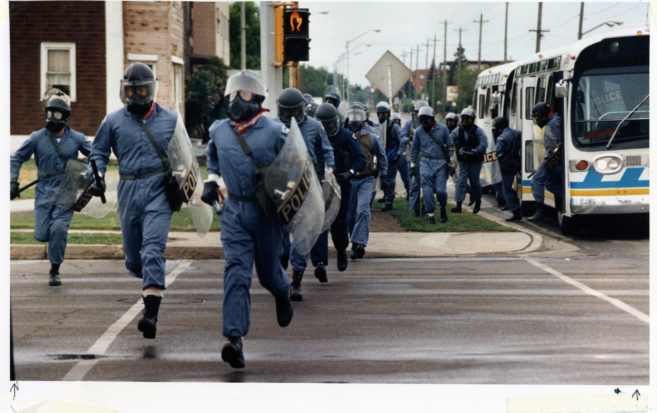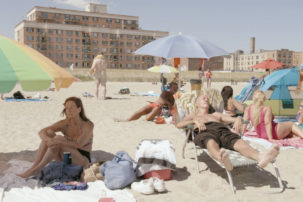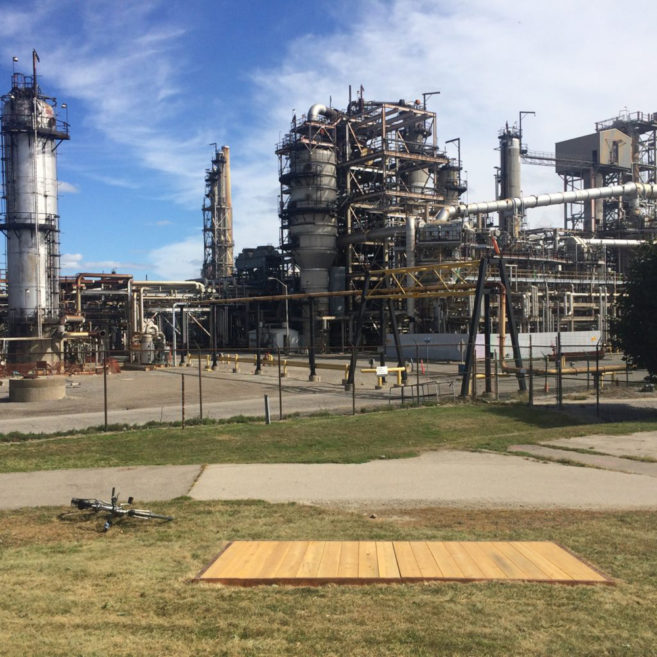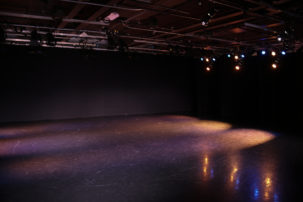A room is filled with brightly coloured floral wallpaper and gorgeous pictures of comets and craters. Two videos play, showing images of starfish, clouds, a narwhal breaching the water, cacti blooming and trees swaying in the breeze. Written on top of these seemingly idyllic, natural scenes are phrases such as, “We heard people trying to dig through the rubble” and “We had always known there was something off about him.” The images oscillate between earthly dwellings and the far reaches of the galaxy, making everything feel slightly strange, a bit off-kilter, otherworldly. Interspersed between sea urchins and baby turtles, more foreboding pictures appear—a bush bursts into flames, smoke emerges from a hole in a city street, a volcano erupts—heightening the overall effect of destabilization. This is a world filled with visions of disaster, and disaster, we are told, derives from the Greek prefix dus, meaning “bad,” and aster, meaning “star.” Using historical and recurring disasters as a framework, Christina Battle’s recent project BAD STARS (2018), an installation which also includes the videos Chemical Valley, Bluecomets and Meteor impacts, finds linkages between destruction and creation, as the juxtaposition of craters and asteroids with plants (many of which are commonly used in bioremediation efforts) implies. The works capture a sense of unease, of apprehension that often seems to permeate our current cultural moment. BAD STARS is a meditation on both natural forces (atmospheric, geologic, environmental) and human forces (social, political), revealing the permeability and vulnerability of bodies to environments, and considering the ways disaster, and its remedies, surrounds us daily.
But there is a tension that arises from thinking of disaster in such general terms—evident in the wide-ranging responses to an email survey Battle sent to a community of artists, scholars and activists, responses which figured disaster as everything from a 19th-century illustration of a sugar-cane plant to images of nuclear disaster to an active-shooter preparedness plan for a classroom—and the more pointed indictment of disaster that Battle herself takes up in one of the exhibition’s central videos, Chemical Valley. For disasters do not arise only from a single external force, like a meteor hitting the earth, but in many cases are deliberate and often preventable creations—the amplification and exacerbation of existing power relations. And sometimes, what may originally appear natural turns out to be, on closer inspection, political. Climate change, arguably the most portentous disaster of our times and one that occupies much of Battle’s thinking and my own, is often portrayed as a natural by-product of progress, where poor and racialized communities “unfortunately” or “coincidentally” suffer the most brutal consequences. However, climate change is not an incidental or accidental event, but rather the amplification of the epistemic violence of extraction (in the form of bodies, minerals and fossil fuels)—the cyclical and reverberating effects of the twinned processes of settler colonialism and chattel slavery.
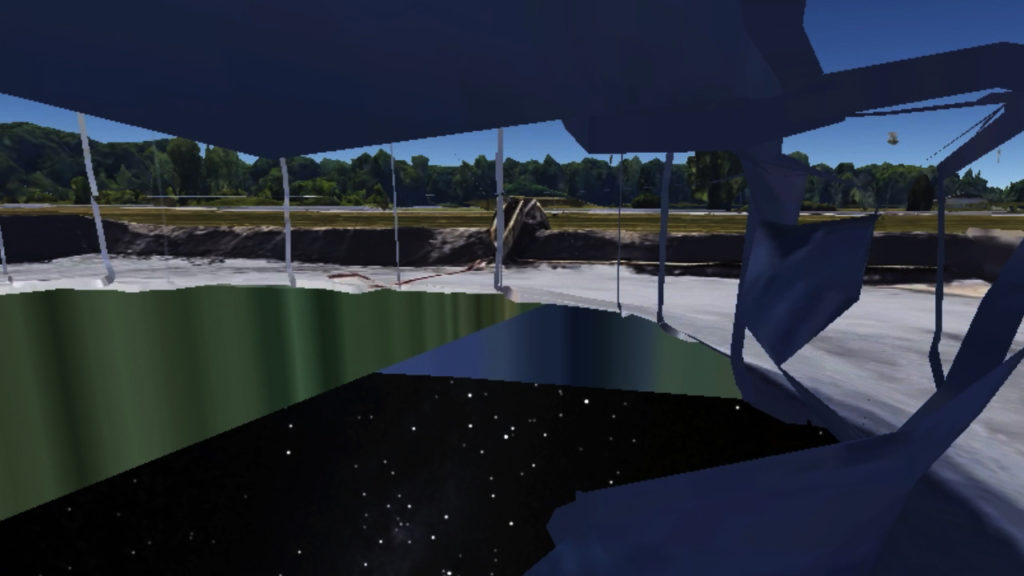
Christina Battle, BAD STARS (video still), 2018. Courtesy the artist.

Christina Battle, BAD STARS (video still), 2018. Courtesy the artist.
We often think of events in the air as natural, but it is becoming increasingly clear that climate change and atmospheric pollution, which produce very different climatic conditions for different populations, are the deliberate molecularization of colonial, capitalist, extractivist politics. In the voice-over to Chemical Valley, Battle narrates, “Diogenes of Apollonia…believed the air to be the one source of all being, a primal and intelligent force, that through condensation and [rarefaction] created all other substances. He believed that the air was capable of creating different worlds.” These words are juxtaposed with jumpy, pixelated and badly rendered Google Earth images of Ontario’s Chemical Valley, located next to Sarnia and Aamjiwnaang First Nation. The 3D landscape sways and bobs, oscillating between strange tree forms and factories that, oddly, resemble dinosaurs; in some cases, the viewer passes through the walls of these petrochemical processing plants on a virtual tour. In this context, it is hard not to read Diogenes’s words as a description of the lively capacities of extractivism, which extend from colonialism through capitalism, radically reshaping the atmosphere. The air is indeed capable of creating different worlds—the atmosphere figured in Battle’s video is one of the most polluted in the country, while the air one breathes in the gallery is the product of filtered air conditioning, sanitized and clean. And as we are currently witnessing, humans are capable of creating atmospheres on a much larger scale, with local climates affected by global circulatory systems.
Kyle Whyte emphatically states that climate change is merely an extension of the colonial logics of displacement and dispossession, changing the biosphere is another tool in undermining Indigenous health, sovereignty and ways of life. As the petrochemical companies of Chemical Valley (Shell Canada, Suncor Energy and NOVA Chemicals among them) participate in the warming of the globe, they also create very specific local atmospheres of harm. Sarnia and the surrounding areas have a higher concentration of airborne fine particulate matter than anywhere else in Ontario, and most other places in the country; Aamjiwnaang First Nation has seen high rates of cancers and disproportionate sexed birth ratios. As is clear in this example, Indigenous peoples, as well as other racialized communities, are often forced to bear a disproportionate burden of the toxic by-products of capitalist extraction, precisely because they are seen as expendable and without political power.
Environmental racism describes this phenomenon of bodily harm and the disruption of relations, where polluting industries are most often located near or in racialized communities, changing local atmospheres and affecting people’s health and well-being. Robert Bullard’s foundational work on environmental racism traced the relationship between polluting industries and African American communities in the United States, showing that the placement of poisonous atmospheres was deliberate, as Black communities were understood to be without political representation to fight back and because Black lives are continually devalued. Christina Sharpe notes that these atmospheres are anti-Black, that the atmosphere is used to perpetuate anti-Black racism. She writes: “In what I am calling the weather, anti-blackness is pervasive as climate. The weather necessitates changeability and improvisation; it is the atmospheric condition of time and place; it produces new ecologies.” Here, the weather, the atmosphere, is itself the environment of anti-Blackness, the wake of slavery that continues to reverberate against the shores of contemporary life. But the weather is not only an evocative metaphor. Sharpe’s definition of atmospheric anti-Blackness is both material and social, both figurative and literal. It can be seen in the high rates of asthma in communities of colour, and especially Black communities. The differential condition of not being able to breathe, how some people literally breathe easier than others, is one indication of the ways in which the atmosphere is not neutral, but rather a material extension of white supremacy.
What makes Battle’s work so compelling, in addition to its strange, surreal juxtapositions and futurist sensibility, is how she situates viewers within this particularly polluted atmosphere in Southern Ontario.
The air, and the particular worlds it creates, is used foremost to enhance the lives of white, wealthy people, while for others, the atmosphere marks how, as Nicholas Mirzoeff writes, colonialism “is palpable to its ruled populations worldwide in terms of unbreathable air.” The first large-scale use of chemical weapons at war was in April 1915, when the German “gas regiment” launched chlorine gas against French and Canadian troops during the First World War, as Peter Sloterdijk has noted. Here, the inherent vulnerability of the body to its outside was put to the service of mass death, a slaughter produced by rendering the atmosphere unbreathable. This weaponization of the air continued throughout the 20th century. In the first instance of militarized “cloudseeding” (the use of chemicals to produce rain clouds and control precipitation), the weather was used as a weapon by the US during Operation Popeye in Vietnam. The jungle was made to turn against its inhabitants in an attempt to conquer the Vietcong, who had used their deep knowledge of the landscape as a wartime strategy. Colonial, imperial and white supremacist logics are not only seen in social formations in these examples, but these logics are molecularized, in the form of air pollution, climate change and war, where racialized communities are most affected.
What makes Battle’s work so compelling, in addition to its strange, surreal juxtapositions and futurist sensibility, is how she situates viewers within this particularly polluted atmosphere in Southern Ontario. Climate change often seems at a remove from many people’s daily lives, and it can be tempting to place blame elsewhere, but Battle asks viewers to consider their proximity to and complicity in environmental racism via the production of colonial atmospheres, harmful pollutants and climate-change impacts. It is hard not to come away from this work feeling unsettled, somehow exposed and vulnerable to the forces of the world, leading the viewer to understand that the production of vulnerability—that is, the production of unbreathability—is often deliberate and differentiated. Battle hopes this project offers “an active strategy that can aid in the shifts in perspective necessary to advance beyond the causes of disasters themselves.”
Understanding the links between climate change, extractivism, colonialism, capitalism and white supremacy provides the basis for broader coalitional politics, broader social movements. Art by itself does not have the capacity, skills or language to take on this monumental task. And yet artists keep making images, videos, drawings and words that speak to these entangled conditions of colonial atmospheres. What do we hope to see, or to create? Are these, in Christina Sharpe’s words, “micro-climates of dissent,” or are they acts of witnessing, repositories of memory, collective processes of mourning? They are, at the very least, productively unsettling.

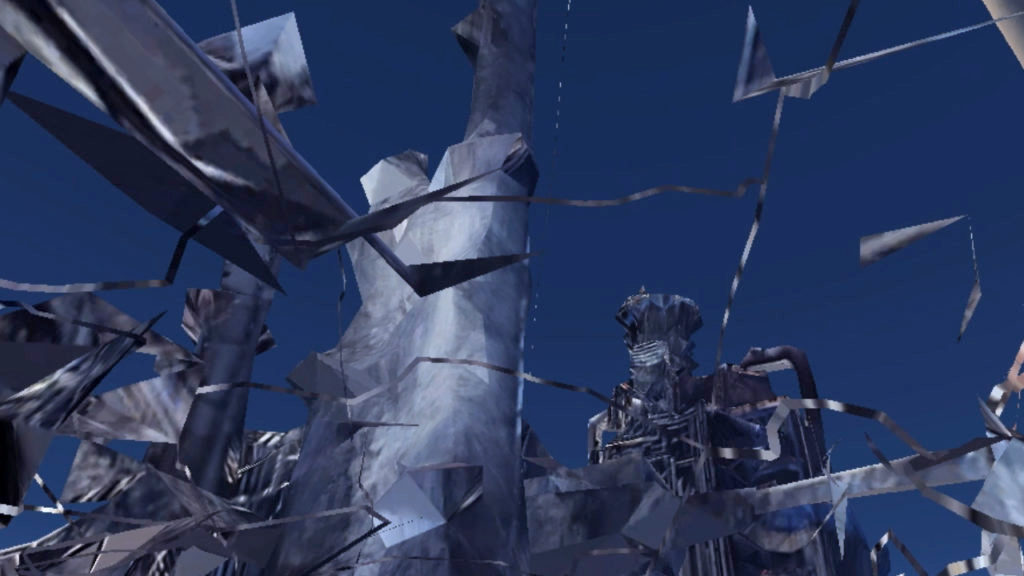 Christina Battle, BAD STARS (video still), 2018. Courtesy the artist.
Christina Battle, BAD STARS (video still), 2018. Courtesy the artist.
